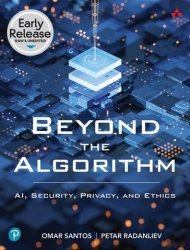 Название: Beyond the Algorithm: AI, Security, Privacy, and Ethics (Early Release)
Название: Beyond the Algorithm: AI, Security, Privacy, and Ethics (Early Release)Автор: Omar Santos, Petar Radanliev
Издательство: Addison-Wesley Professional/Pearson Education
Год: 2023
Страниц: 366
Язык: английский
Формат: pdf, epub
Размер: 17.6 MB
Artificial Intelligence (AI) is increasingly becoming a part of our daily lives. This book offers a comprehensive framework for comprehending and addressing the deeply interrelated challenges of AI, privacy, security, and ethics. It serves as an academic resource and a guide for navigating the complexities of this rapidly evolving terrain. “Beyond the Algorithm” will significantly contribute to ongoing discussions and help shape a future where AI can be both innovative and responsible. The book employs a multidisciplinary approach that draws on insights from cybersecurity, legal studies, philosophy, and Data Science.
Targeted Reading Audience:
This text is written in a technical manner suitable for academic researchers. Still, it has also been structured to be easily understood by policy-makers, legal practitioners, cybersecurity and AI professionals. The in-depth analysis and case studies presented will be particularly enlightening for Computer Science and cybersecurity graduate students. Moreover, anyone interested in comprehending the broader implications of AI will find this comprehensive examination useful.
Chapter 1, “Historical Overview of Artificial Intelligence (AI) and Machine Learning (ML), offers a comprehensive historical overview of Artificial Intelligence (AI) and Machine Learning (ML).
Chapter 2, “Fundamentals of Artificial Intelligence (AI) and Machine Learning (ML) Technologies and Implementations,” delves into the forefront of AI and ML technologies, primarily focusing on Generative Pre-Trained Transformers (GPT), Large Language Models (LLM), and other leading AI technologies. Within this chapter, readers will gain an understanding of essential AI technologies, such as Natural Language Generation, Speech Recognition, and Deep Learning Platforms. It also elucidates AI’s pivotal role in decision management and its consequential impact on optimising decision-making processes. Furthermore, the chapter encompasses topics like biometrics in AI systems, machine learning principles, Robotic Process Automation (RPA), and AI-optimized hardware. It introduces AI classifications, including capability-based types and functionality-based types. This chapter equips readers to analyse the strengths, limitations, and real-world applications of AI and ML, encourages contemplation of societal and ethical implications, and delves into emerging AI trends, empowering them to apply these technologies in practical scenarios effectively.
Chapter 3, “Generative AI and Large Language Models,” explores the concepts of Generative AI, with a particular emphasis on Large Language Models (LLMs). It explores the foundational principles behind these models, their capabilities in generating diverse content, and the transformative impact they have on many sectors, from content creation to automation.
Chapter 4, “The Cornerstones of AI and Machine Learning Security,” Highlights the importance of security in the AI and machine learning landscape and introduces the fundamental principles and best practices essential for safeguarding these systems. It underscores the unique challenges faced in this domain and provides a roadmap for building robust, secure AI applications. This chapter covers, but goes beyond the OWASP top 10 for LLMs and other AI security concepts.
Chapter 5, “Hacking AI Systems,” offers a deep dive into the darker side of AI and examines the various techniques and methodologies employed to exploit vulnerabilities in AI systems.
Chapter 6, “System and Infrastructure Security,” focuses on the broader spectrum of system and infrastructure, this chapter emphasizes the importance of securing the underlying platforms on which AI and machine learning models operate. It discusses best practices, tools, and techniques to ensure the integrity and resilience of the infrastructure, ensuring a fortified environment for AI deployments.
Chapter 7, “Privacy and Ethics: Navigating Privacy and Ethics in an Artificial Intelligence (AI) Infused World,” explores the intersection of Artificial Intelligence (AI) and ChatGPT with personal privacy and ethics. It covers AI’s wide-ranging presence in healthcare, finance, transportation, and communication, explaining how AI underpins recommendation systems, virtual assistants, and autonomous vehicles through data processing and decision-making. The chapter also addresses data collection, storage, and security risks, emphasising user consent and transparency.
Chapter 8, “Legal and Regulatory Compliance for Artificial Intelligence (AI) Systems,” examines artificial intelligence’s legal and regulatory intricacies, emphasising conversational AI and generative pre-trained transformers. By engaging with the chapter and its exercises, readers will gain a deep understanding of the legal and regulatory foundations underpinning the creation of cutting-edge AI.
Contents:
Скачать Beyond the Algorithm: AI, Security, Privacy, and Ethics (Early Release)
